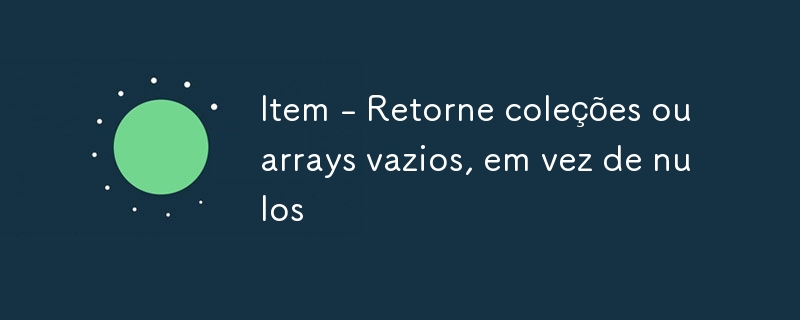Item - 返回空集合或数组而不是 null
发布于2024-11-06

不返回 null:
- 返回 null 代替空集合或数组的方法需要额外的客户端处理以避免异常。
null 问题:
- 客户端需要添加冗余检查(如果要检查null)。
- 这些检查中的遗漏可能会被忽视,从而导致错误。
- 返回集合或数组的方法很难实现。
反对 null 的参数:
- 不要担心分配空集合或数组的性能,除非它被证明是瓶颈。
高效替代方案:
- 使用空集合或数组而不是 null。
- 不可变集合可以重复返回(例如:Collections.emptyList()、Collections.emptySet())。
- 空数组也可以高效返回。
优化性能:
- 使用可重用的空不可变集合以避免不必要的新分配。
- 返回相同的空数组,而不是每次创建一个新数组
代码示例:
返回 null 的错误方法:
// Exemplo incorreto public ListgetCheeses() { return cheesesInStock.isEmpty() ? null : new ArrayList(cheesesInStock); }
客户待遇不足:
Listcheeses = shop.getCheeses(); if (cheeses != null && !cheeses.isEmpty()) { // Lógica para lidar com queijos disponíveis }
返回空集合的正确方法:
// Exemplo correto public ListgetCheeses() { return cheesesInStock.isEmpty() ? Collections.emptyList() : new ArrayList(cheesesInStock); }
使用不可变的空集合:
public ListgetCheeses() { return cheesesInStock.isEmpty() ? Collections.emptyList() : new ArrayList(cheesesInStock); }
与空数组一起使用:
// Retorno de array vazio corretamente
public Cheese[] getCheeses() {
return cheesesInStock.toArray(new Cheese[0]);
}
空数组的优化使用:
private static final Cheese[] EMPTY_CHEESE_ARRAY = new Cheese[0];
public Cheese[] getCheeses() {
return cheesesInStock.toArray(EMPTY_CHEESE_ARRAY);
}
结论:
永远不要返回 null:总是更喜欢空集合或数组。这简化了 API,防止错误,并且很少对性能产生负面影响。
版本声明
本文转载于:https://dev.to/giselecoder/item-54-retorne-colecoes-ou-arrays-vazios-em-vez-de-nulos-1ej6?1如有侵犯,请联系[email protected]删除
最新教程
更多>
-
 在 Hacktoberfest 中做出贡献的新方式:直接在前端 AIHacktoberfest 又回来了,今年为开发者带来了一种令人兴奋的新参与方式。 您现在可以直接通过 Webcrumbs 平台上的 Frontend AI 创建和提交模板,而不是传统的 GitHub Pull 请求。只需前往tools.webcrumbs.org,对模板进行编码,然后在准备好后点击...编程 发布于2024-11-07
在 Hacktoberfest 中做出贡献的新方式:直接在前端 AIHacktoberfest 又回来了,今年为开发者带来了一种令人兴奋的新参与方式。 您现在可以直接通过 Webcrumbs 平台上的 Frontend AI 创建和提交模板,而不是传统的 GitHub Pull 请求。只需前往tools.webcrumbs.org,对模板进行编码,然后在准备好后点击...编程 发布于2024-11-07 -
 为什么使用不带括号的函数指针时“cout”打印“1”?为什么“cout a function without call it (not f() but f;). Print 1 Always?”在此代码中,该代码尝试在不使用括号的情况下“调用”名为 pr 的函数。然而,这实际上并不是调用该函数。相反,它将函数指针传递给 cout 函数。当函数指针隐式转...编程 发布于2024-11-07
为什么使用不带括号的函数指针时“cout”打印“1”?为什么“cout a function without call it (not f() but f;). Print 1 Always?”在此代码中,该代码尝试在不使用括号的情况下“调用”名为 pr 的函数。然而,这实际上并不是调用该函数。相反,它将函数指针传递给 cout 函数。当函数指针隐式转...编程 发布于2024-11-07 -
 JavaScript 中的 require 与 import我记得当我开始编码时,我会看到一些js文件使用require()来导入模块和其他文件使用import。这总是让我感到困惑,因为我并不真正理解其中的区别是什么,或者为什么项目之间存在不一致。如果您想知道同样的事情,请继续阅读! 什么是 CommonJS? CommonJS 是一组用于在...编程 发布于2024-11-07
JavaScript 中的 require 与 import我记得当我开始编码时,我会看到一些js文件使用require()来导入模块和其他文件使用import。这总是让我感到困惑,因为我并不真正理解其中的区别是什么,或者为什么项目之间存在不一致。如果您想知道同样的事情,请继续阅读! 什么是 CommonJS? CommonJS 是一组用于在...编程 发布于2024-11-07 -
 使用镜像部署 Vite/React 应用程序:完整指南在 GitHub Pages 上部署 Vite/React 应用程序是一个令人兴奋的里程碑,但这个过程有时会带来意想不到的挑战,特别是在处理图像和资产时。这篇博文将引导您完成整个过程,从最初的部署到解决常见问题并找到有效的解决方案。 无论您是初学者还是有经验的人,本指南都将帮助您避免常见的陷阱,并...编程 发布于2024-11-07
使用镜像部署 Vite/React 应用程序:完整指南在 GitHub Pages 上部署 Vite/React 应用程序是一个令人兴奋的里程碑,但这个过程有时会带来意想不到的挑战,特别是在处理图像和资产时。这篇博文将引导您完成整个过程,从最初的部署到解决常见问题并找到有效的解决方案。 无论您是初学者还是有经验的人,本指南都将帮助您避免常见的陷阱,并...编程 发布于2024-11-07 -
 我如何在我的 React 应用程序中优化 API 调用作为 React 开发者,我们经常面临需要通过 API 同步多个快速状态变化的场景。对每一个微小的变化进行 API 调用可能效率低下,并且会给客户端和服务器带来负担。这就是去抖和巧妙的状态管理发挥作用的地方。在本文中,我们将构建一个自定义 React 钩子,通过合并有效负载和去抖 API 调用来捕获...编程 发布于2024-11-07
我如何在我的 React 应用程序中优化 API 调用作为 React 开发者,我们经常面临需要通过 API 同步多个快速状态变化的场景。对每一个微小的变化进行 API 调用可能效率低下,并且会给客户端和服务器带来负担。这就是去抖和巧妙的状态管理发挥作用的地方。在本文中,我们将构建一个自定义 React 钩子,通过合并有效负载和去抖 API 调用来捕获...编程 发布于2024-11-07 -
 如何将 PNG 图像编码为 CSS 数据 URI 的 Base64?在 CSS 数据 URI 中对 PNG 图像使用 Base64 编码为了使用数据 URI 将 PNG 图像嵌入到 CSS 样式表中,PNG 数据必须首先编码为 Base64 格式。此技术允许将外部图像文件直接包含在样式表中。Unix 命令行解决方案:base64 -i /path/to/image....编程 发布于2024-11-06
如何将 PNG 图像编码为 CSS 数据 URI 的 Base64?在 CSS 数据 URI 中对 PNG 图像使用 Base64 编码为了使用数据 URI 将 PNG 图像嵌入到 CSS 样式表中,PNG 数据必须首先编码为 Base64 格式。此技术允许将外部图像文件直接包含在样式表中。Unix 命令行解决方案:base64 -i /path/to/image....编程 发布于2024-11-06 -
 API 每小时数据的响应式 JavaScript 轮播I almost mistook an incomplete solution for a finished one and moved on to work on other parts of my weather app! While working on the carousel that w...编程 发布于2024-11-06
API 每小时数据的响应式 JavaScript 轮播I almost mistook an incomplete solution for a finished one and moved on to work on other parts of my weather app! While working on the carousel that w...编程 发布于2024-11-06 -
 用于 Web 开发的 PHP 和 JavaScript 之间的主要区别是什么?PHP 与 JavaScript:服务器端与客户端 PHP 的作用与 JavaScript 不同。 PHP 运行在服务器端。服务器运行应用程序。除其他外,它还处理表单。当您提交表单时,PHP 会对其进行处理。另一方面,JavaScript 是客户端的。它在浏览器中运行。它处理页面交...编程 发布于2024-11-06
用于 Web 开发的 PHP 和 JavaScript 之间的主要区别是什么?PHP 与 JavaScript:服务器端与客户端 PHP 的作用与 JavaScript 不同。 PHP 运行在服务器端。服务器运行应用程序。除其他外,它还处理表单。当您提交表单时,PHP 会对其进行处理。另一方面,JavaScript 是客户端的。它在浏览器中运行。它处理页面交...编程 发布于2024-11-06 -
 如何在 C++ 中迭代结构和类成员以在运行时访问它们的名称和值?迭代结构体和类成员在 C 中,可以迭代结构体或类的成员来检索它们的名称和价值观。以下是实现此目的的几种方法:使用宏REFLECTABLE 宏可用于定义允许自省的结构。该宏将结构体的成员定义为以逗号分隔的类型名称对列表。例如:struct A { REFLECTABLE ( ...编程 发布于2024-11-06
如何在 C++ 中迭代结构和类成员以在运行时访问它们的名称和值?迭代结构体和类成员在 C 中,可以迭代结构体或类的成员来检索它们的名称和价值观。以下是实现此目的的几种方法:使用宏REFLECTABLE 宏可用于定义允许自省的结构。该宏将结构体的成员定义为以逗号分隔的类型名称对列表。例如:struct A { REFLECTABLE ( ...编程 发布于2024-11-06 -
 如果需要准确答案,请避免浮动和双精度float 和 double 问题: 专为科学和数学计算而设计,执行二进制浮点运算。 不适合货币计算或需要精确答案的情况。 无法准确表示10的负次方,例如0.1,从而导致错误。 示例1: 减去美元金额时计算错误: System.out.println(1.03 - 0.42); // Result...编程 发布于2024-11-06
如果需要准确答案,请避免浮动和双精度float 和 double 问题: 专为科学和数学计算而设计,执行二进制浮点运算。 不适合货币计算或需要精确答案的情况。 无法准确表示10的负次方,例如0.1,从而导致错误。 示例1: 减去美元金额时计算错误: System.out.println(1.03 - 0.42); // Result...编程 发布于2024-11-06 -
 在 Go 中使用 WebSocket 进行实时通信构建需要实时更新的应用程序(例如聊天应用程序、实时通知或协作工具)需要一种比传统 HTTP 更快、更具交互性的通信方法。这就是 WebSockets 发挥作用的地方!今天,我们将探讨如何在 Go 中使用 WebSocket,以便您可以向应用程序添加实时功能。 在这篇文章中,我们将介绍: WebSoc...编程 发布于2024-11-06
在 Go 中使用 WebSocket 进行实时通信构建需要实时更新的应用程序(例如聊天应用程序、实时通知或协作工具)需要一种比传统 HTTP 更快、更具交互性的通信方法。这就是 WebSockets 发挥作用的地方!今天,我们将探讨如何在 Go 中使用 WebSocket,以便您可以向应用程序添加实时功能。 在这篇文章中,我们将介绍: WebSoc...编程 发布于2024-11-06 -
 如何在 Python 中使用代理运行 Selenium Webdriver?使用 Python 中的代理运行 Selenium Webdriver当您尝试将 Selenium Webdriver 脚本导出为 Python 脚本并从命令行执行时,可能会遇到在使用代理的情况下出现错误。本文旨在解决此问题,提供一种使用代理有效运行脚本的解决方案。代理集成要使用代理运行 Selen...编程 发布于2024-11-06
如何在 Python 中使用代理运行 Selenium Webdriver?使用 Python 中的代理运行 Selenium Webdriver当您尝试将 Selenium Webdriver 脚本导出为 Python 脚本并从命令行执行时,可能会遇到在使用代理的情况下出现错误。本文旨在解决此问题,提供一种使用代理有效运行脚本的解决方案。代理集成要使用代理运行 Selen...编程 发布于2024-11-06 -
 || 什么时候运算符充当 JavaScript 中的默认运算符?理解 || 的目的JavaScript 中非布尔操作数的运算符在 JavaScript 中,||运算符通常称为逻辑 OR 运算符,通常用于计算布尔表达式。但是,您可能会遇到 || 的情况。运算符与非布尔值一起使用。在这种情况下,||运算符的行为类似于“默认”运算符。它不返回布尔值,而是根据某些规则返...编程 发布于2024-11-06
|| 什么时候运算符充当 JavaScript 中的默认运算符?理解 || 的目的JavaScript 中非布尔操作数的运算符在 JavaScript 中,||运算符通常称为逻辑 OR 运算符,通常用于计算布尔表达式。但是,您可能会遇到 || 的情况。运算符与非布尔值一起使用。在这种情况下,||运算符的行为类似于“默认”运算符。它不返回布尔值,而是根据某些规则返...编程 发布于2024-11-06
学习中文
- 1 走路用中文怎么说?走路中文发音,走路中文学习
- 2 坐飞机用中文怎么说?坐飞机中文发音,坐飞机中文学习
- 3 坐火车用中文怎么说?坐火车中文发音,坐火车中文学习
- 4 坐车用中文怎么说?坐车中文发音,坐车中文学习
- 5 开车用中文怎么说?开车中文发音,开车中文学习
- 6 游泳用中文怎么说?游泳中文发音,游泳中文学习
- 7 骑自行车用中文怎么说?骑自行车中文发音,骑自行车中文学习
- 8 你好用中文怎么说?你好中文发音,你好中文学习
- 9 谢谢用中文怎么说?谢谢中文发音,谢谢中文学习
- 10 How to say goodbye in Chinese? 再见Chinese pronunciation, 再见Chinese learning

























